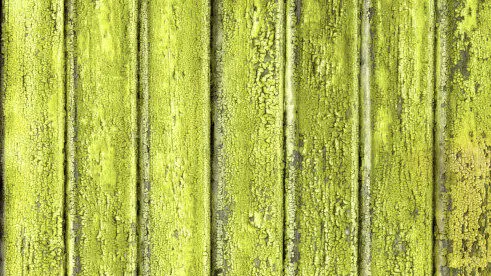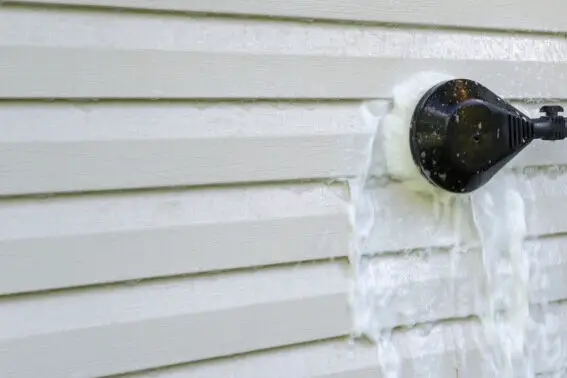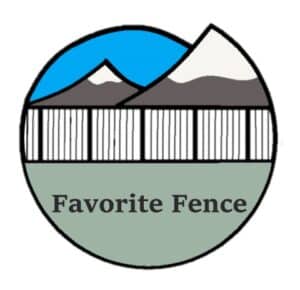Nothing nags at a homeowner’s conscience more than staring at a white vinyl fence covered in green algae. However, cleaning a vinyl fence often gets dropped to the bottom of a to-do list because it seems like a daunting task. The truth is, it is not as difficult as it may seem. Vinyl fencing is easy to clean. With just a few supplies and a little elbow grease a vinyl fence can be cleaned in no time. But, what is the best way to clean a vinyl fence?

Vinyl fencing can be easily cleaned with a mild eco-friendly detergent and a soft scrubbing agent. It is important not to use abrasive scrubbing pads, high-pressure power-washer or toxic cleaners as they can damage the vinyl fence’s protective outer layer and may not be good for the environment.
Vinyl fencing is made out of a PVC material. Its outer layer, the cap-stock, is composed with additional polymers and modifiers that allow it to resist UV rays and degradation from outdoor exposure. A vinyl fence is designed to last for decades. However, using abrasive cleaning methods and potent chemicals on a vinyl fence can damage the cap-stock of the vinyl fence and reduce its integrity.
Vinyl fencing’s non porous surface allows it to be highly resistant to the collection of dirt and grime. Generally, natural rainfall and landscaping watering cycles will provide the only cleaning it will need. However, in some conditions and humid regions, it may be susceptible to mildew and algae growth. To remove mold and algae it is important that the integrity of the vinyl fence material is not compromised. Cleaning a vinyl fence the right way will ensure the vinyl fencing product will be able to durably provide an aesthetically pleasing fencing perimeter for decades to come.
Don’t Clean Your Vinyl Fence Until You Read this First
Though it may seem easy and satisfying to clean a vinyl fence with a powerwasher, the procedure requires fanning the spray very close to the fence in slow linear movements in and out of all the cricks and crannies up and down each panel, rail and post of the fence-line. Not only can this up-close method damage the fence, it can take a long time and use a lot of water and detergent. So, what is the best and most efficient way to clean a vinyl fence?
The best and quickest way to clean a vinyl fence involves just three easy steps:
- Soak a section of fence with a mild detergent.
- Agitate dirt and algae with a large 18-24” soft bristle shop broom. This wide scrubbing agent allows quick ample coverage and efficiently loosens debris.
- Quickly rinse the section of fence with a regular garden hose using a shower spray nozzle.
*For efficiency, while scrubbing one section of fence, make sure the next section of fence is soaking with a mild detergent.

BIG Mistakes when Cleaning a Vinyl Fence: Abrasive Cleaners
- High Pressure Power-washing: it is tempting, and admittedly satisfying, to get up close and personal with a powerwasher to carve away algae with a powerful jetted fan of spray. However, there are several things to consider about powerwashing:
- Powerwashing is not the fastest way to clean a fence.
- The jetted fan of spray can carve away algae, but it can also carve into the vinyl.
- If a powerwasher is used, the pressure should not exceed 2500 PSI.
- The spray tip should be no less than 40°.
- The spray wand should be used no less than 18” from the fence.
- Powerwashing should be used to rinse the fence only and not to strip material.
- Toxic Detergents: there are many very powerful and potent cleaners on the market that can be toxic to humans and to plants. They can also damage vinyl fencing material. These products are not necessary for use on a vinyl fence. Vinyl fencing material is non porous and does not require deep cleaning agents. Cleaning products to avoid are:
- High Concentrations of Bleach: Sodium Hypochlorite can bond to PVC (polyvinyl chloride). The chemical bond can cause free radicals to form in the PVC fence polymers and cause the material to be subject to degradation and fracture.
- High Concentrations of Phosphates: phosphates are toxic to humans and plants and particularly toxic to aquatic systems as its usage can inevitably seep into drainage systems that converge into rivers and lakes.
- Carefully select the detergent to use on your fence and ensure that it does not contain more phosphate content than 0.5% by weight.
- Though it is an effective cleaner, TSP (trisodium phosphate) is highly toxic and should not be used. Due to its high phosphate content, its use has been banned in many states.
- Degreasers: In general, potent degreasers like acetone and xylene, should never be used or needed to clean a vinyl fence. They can cause significant damage to vinyl fencing materials, they are highly toxic and they emit VOC’s (volatile organic compounds) into the atmosphere.
- Abrasive Scrubbing Agents: can scratch or remove the protective cap-stock outer layer of vinyl fencing material causing damage to its integrity. Products to avoid are:
- Magic erasers: these sponge-like cleaning pads work so well because they are made out of a sponge like micro abrasive. Essentially, they are like a fine-grit sand paper. They can strip vinyl fencing material and make it more susceptible to outdoor degradation.
- Stiff Bristle Brushes: Stiff brushes made from plastic, nylon, or metal can scratch and gore into vinyl fencing surfaces and also enhance outdoor degradation.
What Materials are Needed to Clean a Vinyl Fence?
- Soft scrubbing agent: Soft and gentle is the name of the game and can incorporate:
- large soft-bristle brush
- Soft bristle shop broom
- large soft sponge
- large microfiber towel
- Eco-Friendly Detergent:
- Phosphorus Free: Eco-friendly cleaners are considered to be phosphate free if the phosphate content is less than 0.5% by weight.
- Certified with a Green Seal or EPA Safer Choice Label: As outdoor cleaners are expected to be absorbed into the ground and enter into aquatic systems, EPA certified products meet certifications of having minimal environmental impact.
- Examples of some of these products are listed below—all of these options are well rated for their efficacy:
- Simple Green Total Outdoor Cleaner: Safer Choice EPA certified
- Simple Green House and Siding Cleaner: Safer Choice EPA certified
- Simple Green Deck and Fence Cleaner: Safer Choice EPA certified
- Seventh Generation Professional All Purpose Cleaner: Meets Safer Choice EPA
- Gentle Water Rinsing:
- Garden Hose: a shower-spray nozzle works best
- Gentle Cyle Powerwasher: not to exceed 2500 psi
- Safety Gear:
- Eye protection
- Gloves
- Galoshes
Why is it important to use EcoFriendly Detergents When Cleaning a Vinyl Fence?
Outdoor cleaning often involves the use of detergents and degreasers. These cleaners break down grime, kill mold, remove algae and loosen debris. However, what happens to the suds once they are washed away from the outdoor materials and rinsed into the soil or drained into the gutter? Why is it important to use Ecofriendly detergents?
Detergents, cleaners, degreasers, and fertilizers that contain phosphorous, bleach, ammonia, and other chemicals are highly prone to seep and drain into aquatic systems. They have been discovered to be directly correlated to the drastic increase in watershed contamination around the world.
Cleaning agents, regardless of their toxicity, do not disappear when they are rinsed away after cleaning outdoor materials. Typically outdoor cleaning products are drained into the gutter or rinsed into the soil. Cleaners that are drained into the gutter go immediately into a water source. Sometimes these drainage systems are treated, sometimes they feed directly into water systems.
Cleaners that are rinsed into the soil may damage local plants and may eventually seep into the watershed as well. Even cleaners that have a chemical make-up of naturally occurring ingredients can have drastic negative impacts on aquatic systems.
Phosphorus: the Aquatic Killer
For example, phosphorus, or phosphate, is a naturally occurring element and it is one of the building blocks of plant and animal life. Under natural undisturbed conditions, phosphorus is slowly released into soils and aquatic systems through the gradual process of erosion. The natural slow excretion of phosphorus provides natural regulation of the food supply for plant and algae growth. Aquatic animals are able to coexist within a healthy water system that has a balance of food sources and oxygen supply for both plant and animal life.
However, as additional phosphorus is unnaturally added to the water system, plants and algae are given an abnormal abundance of food supply and their growth is accelerated far beyond their natural tendency. Subsequently, the microbes that feed on plants and algae are enabled to reproduce in parallel with the exponential growth of consumption resources available.
It is the excessive concentration of microbes that pose the greatest threat to aquatic animals. As microbes consume, they usurp oxygen from the water source. When an aquatic system becomes imbalanced with the overabundance of plant, algae and microbe stimuli, the oxygen levels for aquatic animals diminish. Unchecked, the continual addition of phosphorus into water systems eventually causes an unsustainable terminal threshold for aquatic animal survival.
In essence, excessive phosphorus, plant, algae and microbes in a water system cause the water to become toxic to fish and other aquatic animals. Fish suffocate and die.
VOC’s (Volatile Organic Compounds) Accidental Danger
Some cleaning agents emit VOC’s when they are expressed into the atmosphere. VOC’s are toxic to humans, plants and animals, and to the atmosphere. Typically, these products are degreasers and crud cutters and can also damage the integrity of vinyl fencing material.
Mixing common household cleaners can have toxic implications. For example: bleach is a very common household cleaner, however, when mixed with other cleaning agents such as ammonia it creates chloramine gas, or when mixed with vinegar it creates hypochlorous acid which then becomes chlorine gas. These gases are highly toxic to humans and emit high levels of VOC’s.
Though single outdoor applications of VOC emitting chemicals don’t have a measurable impact to the environment, the large scale manufacturing, distribution and application of these chemicals have significant environmental consequences.
Sustainability For Your Vinyl Fence and the Environment
Cleaning a vinyl fence with a garden hose and manual scrubbing is the fastest way to clean the fence. It also incorporates the usage of less chemical treatment. However, it does require more elbow grease—which can be a metaphor for some of the difficult changes that industries, manufacturers and consumers are faced with today.
The drastic increase to worldwide atmospheric and watershed contamination has given rise to consumer and manufacturing awareness. New regulations are going through the slow and arduous process of being reviewed and passed to regulate and limit VOC emissions and the proportions of toxic chemicals, such as phosphorous, in cleaning supplies.
Companies are faced with restructuring and re-engineering manufacturing and distribution systems to create new product offerings that are more environmentally friendly . Regardless of whether or not a particular municipality has actually passed measures for regulation, alternative eco-friendly cleaning products have trickled their way onto the shelves to provide more responsible solutions to consumers.
But in the end, it is the consumer who makes the choice and creates the demand. Sometimes, responsibility takes a little elbow grease.

